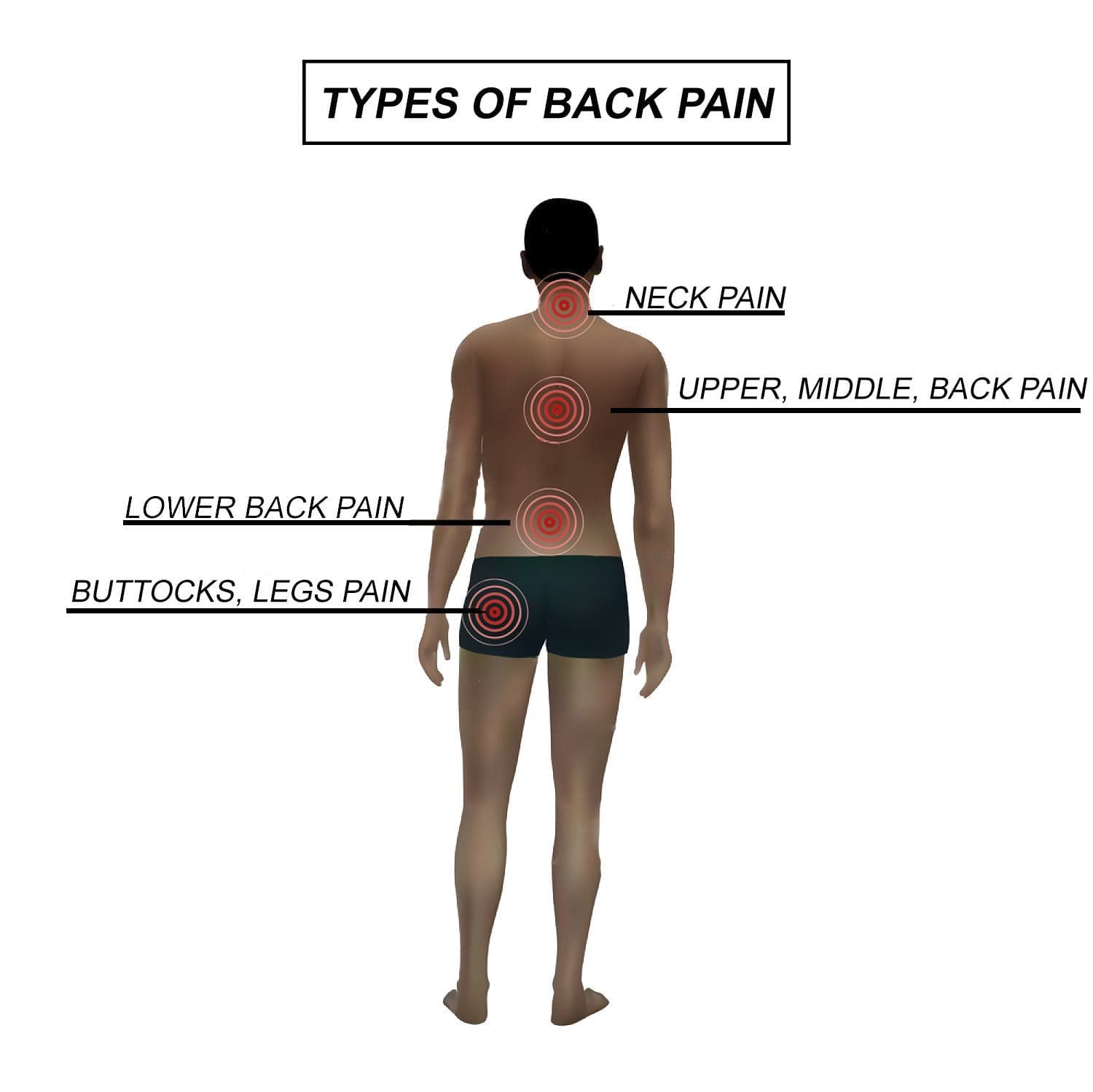Millions of people live with some form of back or neck pain every day. While most of these are only temporary and resolve on their own, many others will continue to experience painful symptoms long after the source of their pain has been treated or healed. Unfortunately, the exact cause of chronic pain is often misunderstood.
Table of Contents
What Causes Chronic Pain?
First of all, what is chronic pain? It is technically defined as pain that lasts for 12 weeks or longer, even after the pain is no longer acute (short-term, acute pain) or the injury has healed. Naturally there are numerous causes of chronic pain that can influence any level of the spine, cervical (neck), mid back (thoracic), low back (lumbar), sacral (sacrum) or a combination of levels (eg, lumbosacral).
Common Causes Of Chronic Pain
Back pain, among one of the most common forms of chronic pain, is a great example to use for this particular cause. Let’s say that over time and through normal wear and tear, you’ve worn out the cartilage that surrounds the joints in your spine (the facet joints). The joints subsequently become swollen, and you develop osteoarthritis in the spine. This inflammation makes it quite painful for you to move, and it is a source of pain. Your damaged facet joints and cartilage may have developed into chronic pain. That’s only one example. Other common back pain causes include:
- Trauma or injury:Â In a car accident, injury and trauma can occur and it might still cause pain once it’s healed.
- Bad posture: Years of slumping over can cause parts of your spine to wear out faster resulting in chronic pain.
- Obesity: It’s well-documented that excessive weight puts strain and pressure on the spine. It can wear quicker or simply not work out as well, possibly leading to chronic pain.
- Aging: Various areas of the spinal anatomy, as well as other joints, may wear out over time (a process called degeneration). There is no guarantee that spine degeneration will be debilitating, however: it depends on how it is affected by the degeneration process, to begin with.
The medical community is not certain severe (short-term) pain occasionally develops to chronic, (long-term) pain after the original pain source was treated. It is possible to learn more about chronic pain, in addition to other kinds of chronic pain, such as fibromyalgia or rheumatoid arthritis.
 Chronic Pain Due To Nerve Damage
Chronic Pain Due To Nerve Damage
Nerves can be damaged or injured in a variety of ways. For instance, a nerve root may be pinched by a herniated disc, causing pain. After healing the herniated disc, the pain can persist because of  the initial nerve damage. Nerves may be injured by arachnoiditis (inflammation of a tissue that protects the nerve roots), arthritis (again, the inflammation may compress the nerve), diabetes, cancer, Lyme disease, an infection, and more. Nerves may have trouble relaying essential neurological communications between the brain and the rest of the body, if they’ve been damaged. One theory about pain is that the nerves don’t stop sending pain signals to the mind, even after the source of pain exists.
Unknown Causes Of Chronic Pain
As you can tell from the preceding two sections, there’s a good deal of doubt when it comes to chronic pain. Through study, the community is starting to better understand pain and its causes, but they can’t pinpoint a cause for chronic pain. That does not mean that they can’t help you find pain relief and approaches to take control of your life again. It’s possible to achieve this with the proper diagnosis and treatments, although it’ll be a process.
Accurate Diagnosis
Obtaining an accurate diagnosis of the cause of your neck or back pain is essential for the result of your treatment plan. Depending upon the severity and cause of your chronic pain, you may have to seek the help of other healthcare professionals, such as pain medicine specialists, spine surgeons, neurosurgeons, physical therapists and/or chiropractors. Over time your pain may need to be reevaluated, and might vary in the way it is managed.
Your chronic neck or back pain treatment generally includes a combination of therapies to optimize outcomes. Some of the treatments your doctor prescribes and recommends may include:
- Physical Therapy: Stretching and strengthening muscles is critical in treating chronic back or neck pain. Your physical treatment may include ice, heat, transcutaneous electrical nerve stimulation (TENS), ultrasound, and myofascial release.
- Chiropractic Care: Based on your diagnosis, chiropractic care may be recommended by your physician. Studies have shown that two weeks of manipulation by a chiropractor may bring about significant improvement in some patients with chronic low back pain and referred leg pain, or sciatica.
- Medications: There are many prescription drugs to treat inflammation, pain, muscle spasms, and pain. Furthermore, there are medications to treat conditions that often accompany chronic pain, such as medication to assist you alleviate depression, sleep, and decrease anxiety.
- Procedures: Your doctor may recommend spinal cord stimulator spinal injections, drug pump, or spinal column operation. You can acquire a second opinion if you are not certain regarding the treatment program recommended.
- Coping skills: Never underestimate the ability of the mind. Your mood and mental prognosis can impact your degree of pain. Assess with a professional to find out relaxation and coping skills.
- Complementary Treatments: Doctors recommend acupuncture and other forms of traditional Chinese medicine. Speak to your doctor.
Fitness & Chronic Pain
While there’s some things you can’t stop from affecting your chronic pain, like the cellular changes which reduce muscle mass and/or bone density, it is possible to take steps to improve fitness which may benefit your symptoms.
It’s known that patients with chronic neck or back pain may not feel like going to the gym, being active or even following a house exercise program. However, being active can help improve chronic pain because during exercise, the body releases endorphins, your body’s natural painkiller.
Furthermore, by teaming up with your physical therapist, it is possible to start to construct abdominal muscles, essential for the core strength which helps support your spine of your body. Several studies show that aerobic exercise is successful in maintaining the integrity of the intervertebral discs in the lower spine, which can lessen back pain.
Were you aware that by losing even 5 to 10 pounds you can reduce back pain? It is true. Carrying around extra weight translates to added stress. In many cases, a difference can be made by early and aggressive therapy of chronic back or neck pain. But keep in mind that knowledge is power: Be certain that you understand your options.
The scope of our information is limited to chiropractic and spinal injuries and conditions. To discuss options on the subject matter, please feel free to ask Dr. Jimenez or contact us at 915-850-0900 .
By Dr. Alex Jimenez
Additional Topics: Wellness
Overall health and wellness are essential towards maintaining the proper mental and physical balance in the body. From eating a balanced nutrition as well as exercising and participating in physical activities, to sleeping a healthy amount of time on a regular basis, following the best health and wellness tips can ultimately help maintain overall well-being. Eating plenty of fruits and vegetables can go a long way towards helping people become healthy.
Injury Medical Clinic: Chronic Pain Treatment
Post Disclaimer
Professional Scope of Practice *
The information herein on "Chronic Pain Causes and Diagnosis | Central Chiropractor" is not intended to replace a one-on-one relationship with a qualified health care professional or licensed physician and is not medical advice. We encourage you to make healthcare decisions based on your research and partnership with a qualified healthcare professional.
Blog Information & Scope Discussions
Welcome to El Paso's Premier Wellness, Personal Injury Care Clinic & Wellness Blog, where Dr. Alex Jimenez, DC, FNP-C, a Multi-State board-certified Family Practice Nurse Practitioner (FNP-BC) and Chiropractor (DC), presents insights on how our multidisciplinary team is dedicated to holistic healing and personalized care. Our practice aligns with evidence-based treatment protocols inspired by integrative medicine principles, similar to those found on this site and our family practice-based chiromed.com site, focusing on restoring health naturally for patients of all ages.
Our areas of multidisciplinary practice include Wellness & Nutrition, Chronic Pain, Personal Injury, Auto Accident Care, Work Injuries, Back Injury, Low Back Pain, Neck Pain, Migraine Headaches, Sports Injuries, Severe Sciatica, Scoliosis, Complex Herniated Discs, Fibromyalgia, Chronic Pain, Complex Injuries, Stress Management, Functional Medicine Treatments, and in-scope care protocols.
Our information scope is multidisciplinary, focusing on musculoskeletal and physical medicine, wellness, contributing etiological viscerosomatic disturbances within clinical presentations, associated somato-visceral reflex clinical dynamics, subluxation complexes, sensitive health issues, and functional medicine articles, topics, and discussions.
We provide and present clinical collaboration with specialists from various disciplines. Each specialist is governed by their professional scope of practice and their jurisdiction of licensure. We use functional health & wellness protocols to treat and support care for musculoskeletal injuries or disorders.
Our videos, posts, topics, and insights address clinical matters and issues that are directly or indirectly related to our clinical scope of practice.
Our office has made a reasonable effort to provide supportive citations and has identified relevant research studies that support our posts. We provide copies of supporting research studies upon request to regulatory boards and the public.
We understand that we cover matters that require an additional explanation of how they may assist in a particular care plan or treatment protocol; therefore, to discuss the subject matter above further, please feel free to ask Dr. Alex Jimenez, DC, APRN, FNP-BC, or contact us at 915-850-0900.
We are here to help you and your family.
Blessings
Dr. Alex Jimenez DC, MSACP, APRN, FNP-BC*, CCST, IFMCP, CFMP, ATN
email: coach@elpasofunctionalmedicine.com
Multidisciplinary Licensing & Board Certifications:
Licensed as a Doctor of Chiropractic (DC) in Texas & New Mexico*
Texas DC License #: TX5807, Verified: TX5807
New Mexico DC License #: NM-DC2182, Verified: NM-DC2182
Multi-State Advanced Practice Registered Nurse (APRN*) in Texas & Multi-States
Multistate Compact APRN License by Endorsement (42 States)
Texas APRN License #: 1191402, Verified: 1191402 *
Florida APRN License #: 11043890, Verified: APRN11043890 *
License Verification Link: Nursys License Verifier
* Prescriptive Authority Authorized
ANCC FNP-BC: Board Certified Nurse Practitioner*
Compact Status: Multi-State License: Authorized to Practice in 40 States*
Graduate with Honors: ICHS: MSN-FNP (Family Nurse Practitioner Program)
Degree Granted. Master's in Family Practice MSN Diploma (Cum Laude)
Dr. Alex Jimenez, DC, APRN, FNP-BC*, CFMP, IFMCP, ATN, CCST
My Digital Business Card
RN: Registered Nurse
APRNP: Advanced Practice Registered Nurse
FNP: Family Practice Specialization
DC: Doctor of Chiropractic
CFMP: Certified Functional Medicine Provider
MSN-FNP: Master of Science in Family Practice Medicine
MSACP: Master of Science in Advanced Clinical Practice
IFMCP: Institute of Functional Medicine
CCST: Certified Chiropractic Spinal Trauma
ATN: Advanced Translational Neutrogenomics





 Again, We Welcome You.
Again, We Welcome You.
Comments are closed.